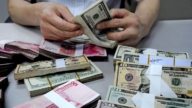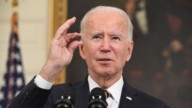【新唐人2014年07月26日讯】目前在中国大陆“资产证券化”产品,时隔7年再现江湖,各银行、金融机构,甚至就连国营企业都在争相发行“资产证券化”产品。官方媒体就此发文,嚷嚷可以期待信贷资产证券常态化。不过外界认为中国金融界的这一举动,是在中国经济处于严重脆弱时,中共当局企图从老百姓的腰包中掏出最后一个子的歪招。
7月22号,中国邮政储蓄银行,发行的人民币68亿元“住房抵押贷款支持证券”正式上市,同一天招标发行的,还有中信银行61亿元的资产支持证券化产品,和台州银行的5.3亿资产支持证券化产品。
所谓“资产证券化”,就是把那些缺乏流动性,但具有可预期收入的资产,以发行证券的方式予以出售,来获取融资。
大陆《金融时报》7月22号发文,为“资产证券化”叫好。文章说,近期“资产支持证券”产品的发行人,已经从国家开发银行、大型商业银行等,扩展到城商行、汽车金融公司等,“基础资产”也涉及了个人住房贷款、汽车抵押贷款等多个类别。标志着中国信贷资产证券化,逐步向所谓常态化迈进。文章还引用多个专家的话,论证所谓的“资产证券化”如何可靠。
美国南卡罗莱纳大学艾肯商学院教授谢田:“这实际上是一个明火执仗的抢劫,中国金融证券处于一个非常脆弱的地步,中国政府还在大量推这些东西,从券商到媒体到政府到发行商,都是统一口径的吹捧叫好,人们并不能够真正清醒的认识到,资产支持证券的风险在哪里。实际是在公然欺骗中国的百姓。”
“资产支持证券”,又称“ABS”。它将公司的特定资产或某项现金流,作为融资抵押资产,而不是以公司整体名义来融资,因此减少融资成本,也可以限制偿债风险。
与股票和一般债券不同,“资产支持证券”不是对某一经营实体的利益要求权,而是对“基础资产池”(pool of underlying assets)所产生的现金流和剩余权益的要求权,是一种以资产信用为支持的证券。
因而“资产支持证券”产品相关的本金支付时间,具有不可预见性。
大陆企业观察家何军樵:“因为现在整个金融业是非常腐败的,也是非常黑暗的,资产证券化无非就是甩包袱,就是希望这些负债的资产由当地的老百姓去承担,企图将这些债务转嫁到老百姓身上,反正中央政府没办法了就想办法,这都不是正道。”
中国2005年开始允许“ABS”试点时,受到了广泛抨击,2009年“ABS”项目不得不停止。2012年中国又重新启动了这个项目,并逐步扩大规模。
中国支持“ABS”理论者,是以美国等西方国家早就有了“ABS”为理由。
谢田:“美国也有很多金融产品、证券产品,是由私人公司来进行的,美国政府恰恰是在起一种监督和检查的作用,完完全全彻底的披露所有的风险,一旦政府发现券商有欺诈行为,政府会直接起诉,政府没从中获利,实际上是保护消费者的权益的,在中国恰好相反,媒体也帮着欺骗。”
根据国际“渣打银行”(Standard Chartered)大中华区研究部主管王志浩(Stephen Green)的估算,到今年6月底,中国总债务与国内生产总值(GDP)之比,已经达到251%。
而中国国内债务到期无法偿还的现象也在不断涌现。例如,山西“华通路桥集团”的4亿元债务,在7月23号到期,面临违约,最终由山西省政府亲自出面干预,才完成债务偿付。这个集团在上半年也曾出现超日债违约,同样由政府出面兜底。
近期,更多的实质违约债券爆出,7月10号,由浙商证券承销的“12金泰债”遭遇本息无法兑付。据国内媒体报导,有590亿民企债务出现兑付危机。
那么,这些债务最终由政府出面以印制钞票方式解决,导致通货膨胀,谁才是受害者呢﹖
采访编辑/刘惠 后制/钟元
Asset Securitization Appears Again
Expert: Risk is Shifted to the People
Asset securitization products appear in China again
after an interval of 7 years.
Banks, financial institutions, and state-owned
enterprises are scrambling to release asset securitization
products.
The official media demanded the normalization of credit
asset securitization.
It’s believed to be the last trick to pull the last money out of
the people from Chinese Communist Party (CCP) in such
seriously vulnerable economic conditions.
July 22, China Postal Savings Bank issued mortgage securities
to the value of 6.8 billion RMB.
The same day, the CITIC Bank issued asset securitization
products of 6.1 billion RMB by tender and Taizhou Bank
issued asset securitization products worth 530 million RMB.
Asset securitization is to sell assets which
lack liquidity but with predictable income by issuance of
securities to obtain finance.
July 22, mainland Financial Times issued an article to boost
asset securitization.
The article said that recent asset securitization product
issuers have moved from the National Development Bank,
large commercial banks to the city commercial banks, auto
finance companies, etc.
The underlying asset also involves multiple categories
including individual mortgages, and car loans.
It means China credit asset securitization gradually moves
to so-called normalization.
The article also cited a number of experts to demonstrate
how reliable this so-called asset securitization is.
Professor Xie Tian, University of South Carolina
School of Business: “this is actually blatant robbery.
Chinese financial securities are at a very vulnerable point;
but the Chinese government is still puffing it up.
Security traders, the media, the government are united
in their applause.
People cannot truly understand the risk of asset-backed securities.
It’s actually a blatant fraud on the Chinese people."
Asset-backed securities are also known as ABS.
It uses a specific asset or a cash flow as mortgage assets for
finance, rather than the overall company finance.
Thereby, it reduces financing cost and limits debt risk.
ABS is different from stocks and bonds, it doesn’t claim
on the interests of a specific operating entity, but claims
on the cash flow and residual interest generated by the pool
of underlying assets.
It is kind of stock supported by asset credits.
Thus, principal payment time for ABS related products
is unpredictable.
He Junqiao, mainland corporate observer: “Asset securitization
is nothing more than dumping the burden to let people take
the debt as the whole financial industry is corrupt and dark.
The attempt is to shift these debts to the people
so the central government would have a way out.
It is not the right way."
The ABS pilot program has been widely criticized since it
started in 2005.
In 2009, the ABS project had to be stopped.
In 2012, China restarted the project and gradually expanded it.
The reason that someone supports ABS in China is because
the US and other Western countries have used it for a long time.
Xie Tian: “There are a lot of financial products,
securities products used by private companies in U.S.
The US government precisely takes the supervision and
inspection role to completely disclose all risks.
Once the government finds fraud from the securities
trader, the Government will directly prosecute without profit.
It is in fact to protect the interests of consumers.
The Chinese government is just the opposite.
The media also helps to deceive. “
According to the head of the Greater China research team in
Standard Chartered Bank Stephen Green’s estimate, by the end
of this June, China’s total debt has reached 251% compared to
gross domestic product (GDP).
There are lots of due debts can not be paid in China.
For example, the Shanxi Huatong Road & Bridge Group Co.
400 million yuan of debt expired on July 23 facing default.
Eventually, the Shanxi provincial government intervened to
complete debt repayment.
There was other debt default in the first half year and the government
also came out to solve it.
Recently, more essential default debts were exposed.
July 10, 12 Jintai debt which is underwritten by Zhejiang
Securities could not pay the principal and interest.
According to domestic media reports, 59 billion private
enterprises’ debt payments are in crisis.
These debts were solved by the government through printing
money which resulted in inflation.
Who is the real victim?
Interview & Edit/Liu Hui Post-Production/Zhong Yuan





























